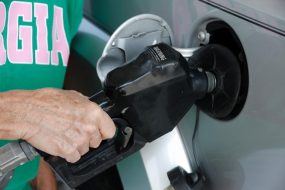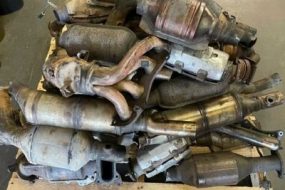
Water and fuel should not mix, but they do. Water is denser than fuel, therefore, causing lots of harm to the car. The gas tank can have water in it naturally because the composition of fuel allows for a small percentage of dissolved water.
Is it possible to know the amount of water that will ruin a car? How much water in a gas tank will ruin a car?
The right amount of water to have in the gas tank to ruin a car cannot be fully determined, this is because irrespective of the amount present inside, water in the gas tank, if not flushed out immediately will cause serious damage to the car.
A cup full of water or less has been said to cause damage to a car but this will mean considering the size of the cup. It is better to take preventive measures against water getting inside the gas tank.
Should Water Enter Your Gas Tank?
No, you shouldn’t allow water to enter your gas tank. Although it is advisable you do all you can to prevent water from entering your gas tank, you will experience these at least once in the lifespan of your car.
These may happen due to situations that are no fault of yours as a car owner but unfortunately, you will be the one dealing with the problem.
Water can get inside the tank when the car fuel cap is left open or is bad, this allows water, especially rainwater.
It could also be from the gas station, there have been cases of contaminated fuel and the selling of fuel mixed with water in some areas because of scarcity.
The water in your tank doesn’t have to be much, the littlest of water in the gas tank can cause lots of damage to your car, however, the quantity of water inside will determine the extent of the damage.
How Much Water in a Gas Tank Will Ruin a Car?
Water in whatever amount is bad for a car, but the truth is a small amount of water may get inside the gas tank naturally. This is because fuel is usually composed of some amount of dissolved water. In this case, little or no damage may be caused to the car.
However, water in amounts more than that can cause serious damage. Determining the amount of water enough to ruin a car isn’t really conclusive because the littlest of water is enough to cause damage.
The volume of the cylinder in the engine may help in getting a more accurate answer, a cup filled with water or less can ruin a car.
But of course, no one will knowingly pour a cup of water into the gas tank except as a prank which will turn out to be a costly one. Therefore, stop asking how much water in a gas tank will ruin a car and ensure water never gets to your gas tank.
What Will Water Do to Your Car if it Enters Your Gas Tank?
- Stalling Engine: Water in a gas tank can cause the engine to stall. If you are able to start the car which is unlikely, the engine will stall due to weak combustion.
- The Engine will not Start: Lack of enough fuel will prevent the engine from functioning well and results in its refusal to start.
- The Fuel Efficiency will be Reduced: Water in the gas tank reduces the engine power. The engine consumes the same amount of fuel but for shorter distances, you now use more fuel than usual.
- Rust in the Gas Tank: It could also cause rust when the water settles and is present over a period of time in the tank. Rusting can eventually lead to holes in the fuel tank.
- You May Have a Failed Injector to Deal With The injector is responsible for supplying fuel to the combustion by spraying the right quantity of fuel all things being equal.
Water mixed with fuel will disrupt this process as it is denser than fuel. If this isn’t checked in time, it could result in injector failure. Therefore, you should never allow water to get to your engine.
How to Prevent Water from Entering Your Gas Tank
There are steps you can take to reduce and curb its effect on the car or prevent it altogether. Some of these steps are mentioned below:
1. Keeping the Gas Tank Full
Condensation will be reduced if the gas tank is kept full at all times, especially during hot weather.
2. Bulk Storage Tank should be Checked Often
Fuel Storage tanks should be checked often for condensation accumulation. Not doing these will result in water being drawn alongside the fuel.
3. Water Finding Paste should be used on Gas Tank
Using a water-finding paste with a dipstick will help you know if water is present in the tank. If water is inside, the paste changes color. This should be done as often as possible.
4. A Shield Cap should be Placed on the Vent Cap
For an underground tank, a shield cap should be placed on the vent cap, this is to protect the vent cap from rain.
5. The Fuel Cap should be Sealed Properly
In order to prevent rain from entering the gas tank, the fuel cap should be sealed properly and changed if it is bad.
How Do You Clean Water from Your Gas Tank?
Not having water in a gas tank is nearly impossible, therefore, it is important to find a way to clean out the water when it does. The method to use will be dependent on the water inside.
Here are some known and proven ways to clean water from the gas tank:
- One way is by draining the gas tank and then refilling it with new fuel, this method may require the removal of the tank at least, you are sure the water is all gone.
- Depending on the car model, some engines are designed in ways that allow water to drain out through valves present underneath the gas tank. This process doesn’t affect the fuel at all.
- A hose and canister can also be used to drain the content of the gas tank.
Conclusion
Knowing how much water in a gas tank will ruin a car is not important. However, it is important that as many as can measures be put in place to prevent water from getting inside the gas tank, and in the event that it enters you find ways to flush it out.
The extent of the damage done will help you determine if a simple flushing or engine replacement will be required.
Also, when driving through water or during a heavy downpour, ensure that water can never find its way to your gas tank.









